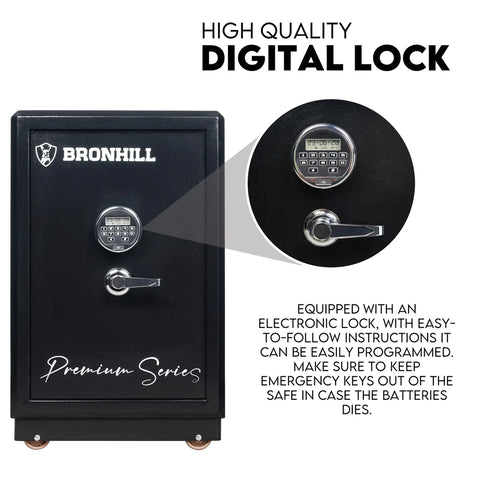In the world of firearm safety and security, the effectiveness of gun safes is a topic ripe with discussions, myths, and often, misunderstandings. As responsible gun owners seek the best ways to secure their firearms, questions about the true capability of gun safes to protect against unauthorized access and environmental damages arise. Are gun safes merely a deterrent, or do they offer genuine security? This article delves into the reality behind gun safes, exploring their design, technology, and the standards that measure their effectiveness.
By shedding light on the critical features that define a high-quality gun safe and debunking common myths, we aim to provide a clearer understanding of what makes gun safes an essential part of firearm safety.
Understanding Gun Safe Security Features
When evaluating the effectiveness of gun safes, it's imperative to understand the key security features that contribute to their ability to protect firearms from unauthorized access and environmental damage. This section delves into those critical features, providing insights into what makes a gun safe genuinely secure.
1. Locking Mechanisms: The First Line of Defense

- Types of Locks: Explore the various locking mechanisms used in gun safes, including traditional key locks, combination dials, electronic keypads, and biometric scanners. Each has its advantages and considerations in terms of security, ease of use, and reliability.
- Biometric vs. Non-Biometric: Discuss the growing popularity of biometric locks for their quick access capabilities, while also acknowledging potential vulnerabilities and the importance of having reliable backup options.
2. Material Strength and Construction Quality
- Steel Gauge: The thickness and quality of the steel used in a gun safe's construction are paramount. A higher gauge number indicates thinner steel; thus, lower gauge steel is preferable for enhanced security.
- Welds and Seams: The integrity of a safe's construction, including how its parts are welded together, can significantly impact its resistance to forced entry. Seamless welds offer fewer vulnerabilities.
3. Fire and Water Resistance
- Fireproof Ratings: Understand how safes are rated for fire resistance, including what the ratings mean in terms of temperature and duration. This feature is crucial for protecting firearms and important documents in the event of a fire.
- Waterproof Features: Discuss the importance of waterproofing in gun safes, especially for those located in basements or areas prone to flooding. This can prevent rust and corrosion of firearms and ammunition.
4. Tamper-Resistant Features
- Anti-Drill Plates: Highlight the role of hard plates installed around the lock and other critical areas to resist drilling attempts.
- Locking Bars and Bolts: Examine how the number, size, and placement of locking bolts or bars contribute to a safe's ability to withstand prying and other forms of physical attack.
5. Additional Security Enhancements
- Alarm Systems: Some gun safes include or can be connected to alarm systems that notify owners of unauthorized access attempts.
- Smart Safe Technologies: Explore advancements in safe technology, such as safes that can send alerts to your smartphone or integrate with home security systems for increased monitoring and control.
6. Making the Right Choice
Choosing a gun safe with the right combination of security features is critical for ensuring the safety of your firearms and the peace of mind that comes with knowing they are well-protected. Consider your specific needs, the potential risks in your environment, and the level of accessibility you require when selecting a gun safe. Investing in quality and advanced security features can significantly enhance the effectiveness of your gun safe, providing robust protection against both unauthorized access and environmental damages.
Myth vs. Reality: Debunking Common Misconceptions
When it comes to gun safes, numerous myths circulate among gun owners and enthusiasts, potentially leading to misinformed decisions about firearm security. It's essential to distinguish between fact and fiction to ensure you're relying on accurate information for the safety of your firearms. This section aims to debunk some of the most common misconceptions surrounding gun safes.
1. Myth: Gun Safes Are Easily Breached by Thieves
Reality: While no safe is impervious to all forms of attack, high-quality gun safes are designed to offer significant resistance to unauthorized access. Certified safes, especially those with high security ratings are rigorously tested to withstand a variety of break-in methods for a specified duration. The effectiveness of a safe against theft largely depends on its construction, locking mechanism, and installation quality.
2. Myth: Fireproof Gun Safes Completely Protect Contents from Fire Damage
Reality: Fireproof gun safes are designed to protect their contents from heat and smoke damage up to certain temperatures and for a specific period. However, the term "fireproof" can be misleading, as no safe is entirely invulnerable to fire. The key is to look for safes with a certified fire rating that indicates the maximum temperature and length of time the safe can withstand fire while protecting its contents. It's also crucial to place the safe in a location that minimizes fire risk.
3. Myth: A Gun Safe in the Home Increases the Risk of Accidental Shootings
Reality: Properly used gun safes significantly reduce the risk of accidental shootings by restricting unauthorized access, especially by children. The key factor is responsible usage, which includes using a reliable locking mechanism and ensuring the safe is secured in an accessible yet discreet location. Educating all household members about gun safety and the importance of the safe further enhances security and safety.
4. Myth: Biometric Safes Are Unreliable and Easy to Hack
Reality: Modern biometric safes have come a long way in terms of reliability and security. High-quality biometric safes use advanced fingerprint recognition technology that is difficult to deceive. Furthermore, many of these safes incorporate backup access methods, such as keys or numerical codes, ensuring access even if the biometric sensor fails. As with any technology, the effectiveness of a biometric safe depends on its construction, the quality of its components, and regular maintenance.
5. Myth: Gun Safes Are Only Necessary for Those with Children in the House
Reality: While gun safes are crucial for households with children, they provide essential benefits for all gun owners. Beyond preventing unauthorized access by minors, safes protect firearms from theft, damage, and unauthorized use by anyone who shouldn't have access, including visitors, burglars, or anyone else who might enter your home.
Debunking these myths clarifies the importance of making informed decisions based on factual information when it comes to gun safes. By understanding the realities of what gun safes can and cannot do, you can better assess your needs and choose a safe that offers the best protection for your firearms, ensuring safety and peace of mind.
Enhancing the Effectiveness of Your Gun Safe

Once you've chosen a gun safe that meets your security needs, there are several strategies you can employ to maximize its effectiveness. Enhancing your gun safe's security doesn't just stop at purchase; it involves thoughtful placement, usage, and integration with other security measures. Here are key tips to ensure your gun safe provides the utmost protection for your firearms.
1. Optimal Placement for Increased Security
- Strategic Location: Place your gun safe in a location that balances accessibility with security. Avoid obvious spots like the master bedroom or garage, which are the first places an intruder might check. Consider less obvious locations that are still accessible to you in an emergency.
- Concealment: Use creative ways to conceal your safe, such as behind a false wall, inside a closet, or beneath furniture. Concealment reduces the chances of your safe being targeted by burglars.
2. Leverage Technology for Enhanced Protection
- Smart Locks: Consider upgrading to a smart lock that alerts you on your phone if your safe is tampered with. Smart locks can also offer remote access logs, showing who opened the safe and when.
- Security System Integration: Connect your gun safe to your home's security system. This way, any tampering or unauthorized attempts to access the safe can trigger an alarm or send notifications to your security provider or directly to your smartphone.
3. Regular Maintenance and Upgrades
- Lock Maintenance: Regularly check and maintain the locking mechanism of your safe to ensure it functions correctly. This might involve cleaning, lubricating, and adjusting components as necessary.
- Software Updates: For electronic or biometric safes, keep the software up to date. Manufacturers may release updates to improve security features or fix vulnerabilities.
4. Backup Access Plan
- Emergency Access: Ensure that there is a reliable backup access method in case the primary lock fails or if you need to grant access to someone you trust in an emergency. This could be a physical key, a secondary code, or a backup fingerprint for biometric safes.
- Secrecy of Access Codes: Be cautious about who knows the access codes or has fingerprints registered in the safe. Limit this knowledge to those who absolutely need access, and change codes periodically for added security.
5. Educate and Train Authorized Users
- Safe Operation: Train any authorized users in the proper operation of the safe, emphasizing the importance of keeping the access method confidential.
- Emergency Response: Discuss and practice what to do in various scenarios where accessing the safe quickly is necessary. This ensures everyone knows how to respond efficiently and safely in an emergency.
To make your gun safe work well, it's not just about buying a good one. You also need to put it in the right place, add extra security, keep it maintained, and teach authorized users. By taking these steps, you can significantly enhance the protection of your firearms, ensuring they remain secure and accessible only to those permitted to use them. Remember, a gun safe is a critical component of your overall home security strategy and responsible firearm ownership.
For further insights and comprehensive guidance on optimizing your gun safe usage, don't miss our detailed article, "Optimizing Gun Safe Usage." This resource offers valuable information on making the most of your gun safe, enhancing its security and functionality.
As you consider securing your firearms more effectively, we invite you to explore our range of high-quality gun safes. Our selection is designed to meet a variety of needs, offering the latest in security technology and compliance with strict safety standards. Whether you're seeking robust theft protection, fire resistance, or advanced access options, our product listings have you covered.
Take a step towards enhanced firearm safety today by checking out our gun safes. Your peace of mind is our priority, and we're here to help you find the perfect solution for your safety needs.

